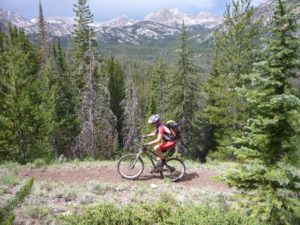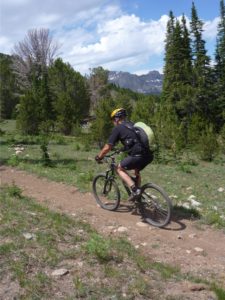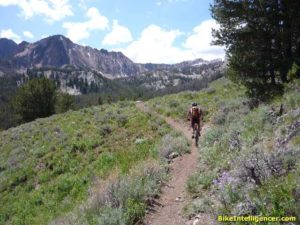[In which our knobbied clan avoids suspect mycology, eludes the crackling dangers of a fearsome electrical storm, performs expert on-trail bike maintenance and endures the dodgy pitfalls of horse-putrified bogs.]
After Boundary Creek got done wringing us out, we headed to the bucolic little burg of Stanley, hard by the Salmon River. First on the agenda was finding a camp site. There are plenty of campgrounds off Highway 75 just beyond Stanley and we had little trouble getting one within 200 feet of the river. We jumped in to cool down; the water was unexpectedly warm even though the river seemed a bit high and the current was strong.
What Stanley lacks in quantity it makes up for in quality. Our fave place for dinner is the Bridge Street Grill, which has a deck right out over the river where there’s some kind of steel bridge — no guard rails — that looks for all the world like a girder laid sideways over the gap. Motorbikes, scooters, small children … they all crossed the bridge, the latter even playing a game of tossing flowers into the river, then running to the other side of the bridge to see them pass beneath in the current. Ah the simple joys of youth — if you don’t fall in, that is. We seemed a lot more worried about the prospect than they did.
I’ve gotten to the point where I avoid eating meat if I can, but that can be a bit of a stretch in a place like Stanley, Idaho. The only veggie thing on the menu was a mushroom burger. I’ve liked most mushroom burgers I’ve eaten, but once in the similarly carnivorous small town of Winthrop WA I ordered a mushroom burger that subsequently arrived containing a huge steak patty with a portobello mushroom on top. So I figured on asking our Stanley waiter what kind of mushrooms the burger came with. I’m thinking maybe portobello, maybe shiitake. Perhaps the morels were already in. Button, crimini and porcini I would probably take a pass on.
“So,” says I, “what kind of mushrooms are in the mushroom burger?”
The waiter, who later turned out to be an actual bull rider called in when the regular help was sick, thought for a moment and said, “Um … non-hallucinogenic?”
You can see why we love this place.
I went with the BBQ chicken sandwich, which was quite tasty. And we left our cowpoke friend, clearly out of his element but endearingly solicitous of our every request, a big tip.
At dinner we asked around for a place to get breakfast, and everyone agreed that would be the bakery.
“What’s it called?” we asked.
“The Bakery,” they said.
“Just … the Bakery?”
“That’s right.”
“It’s the only place I ever eat breakfast,” our waiter chimed in.
“There isn’t any other place to eat breakfast,” a couple at the next table noted. [A complete list of Stanley dineries here.]
Later we spoke with the owner of the Grill, who acknowledged he’d tried serving breakfast for a while but “it didn’t work out.” Customers were not the problem — it was getting help.
“People come and go,” he said. “You never know if someone’s going to report for work or not.”
We asked him the population of Stanley. He thought for a bit.
“It must be up around 70,” he said. “A Mormon family moved in with 8 kids.”
After sleeping soundly with the whispering river providing soothing white noise, we rose and hustled over to The Bakery. It was packed with cyclists, largely because of a big road ride in town. But we got seated fairly expeditiously and enjoyed a huge bowl of steaming oatmeal with berries. They also had signature hearty fare, including flapjacks the size of frisbees. We finished up and were soon on our way. Which was good, because we had a long ride ahead of us.
A few years back we’d spent time in Stanley planning to do Big Boulder/Little Boulder, an epic backcountry loop that requires an hour-plus drive from Stanley just to the starting point on East Fork Salmon River Road, 18 miles in from Highway 75. We’d gotten too late of a start to do the loop, though, which meant an out-and-back, or up-and-down, ride on Big Boulder. That was a screaming downhill, one of the best we’ve ever had. But it left us craving the entire ride.
Because the Big Boulder downhill is so spectacular — 6.5 miles of non-stop ripping over buff singletrack with G-force straightaways — you’re forced to make a decision at the start. Do you go up Little Boulder and down Big, or the other way around? Since we’d already done the down Big thing, we decided to go up Big and down Little. The ride profile showed that to be a lot longer downhill, even if our local tipster (Don Wiseman) had warned us of lots of rocky sections.
The primary thing to remember, no matter which direction you take, is to park at the dirt-road turnoff from East Fork Salmon River Road. You do NOT want to ride the dirt road to or from the trailhead at the END of the loop, no matter which way you do it.
We parked and geared up. It was approaching 80 degrees and I was thinking, another hot one.
“Should I take along my rain jacket?” I asked Jim.
“What do you think?” he said.
Jim always answers what he considers boneheaded questions with a Zen koan or something, which is only fair because by now he knows my chief problem is that I don’t think.
“There’s not a cloud in the sky. It’s pushing 80 degrees out. What’s the point?” I asked him back. He just smiled and rolled his eyes.
Doing the dirt road up to the trail head at the start of the ride isn’t a bad thing. You get to stretch your legs a bit and, dusty and uninspiring though it be, you’re fresh and looking forward to a day of spectacular riding. We were kind of hoping one of the hikers or good ol’ boys who passed us on the way would give us a ride, but no luck. Yeah it would’ve been cheating, but an honest kind of cheating.
The climb up Big Boulder is gentle, beautiful, scenic and altogether pleasant. About half way up, the sky began to darken. Then it got darker. In a few minutes it was all but black. Lightning crackled to the northwest, thunder rattled the ridge and fat splotches of sloppy rain began pelting down on us.
Even though we were riding carbon bikes, Jim cautioned we could get struck by lightning or otherwise imperiled if lightning chose a tree close by. We crawled down off the trail and took refuge in a small stand of pine.
“You don’t want to be near the tall trees,” Jim said. They’re likeliest to get hit.
Jim got out his rain gear and was soon covered up. When I pulled out my yellow Patagonia jacket, he did a double-take.
“Glad I followed your advice,” I said.
The rain was coming down hard but Jim, who once was a rock climber and professional mountain guide, scanned the horizon and said, “It’ll be over in 15 minutes or so.” For the time being, all we could do was sit and wait.
When the rain did stop, the skies opened back up and we resumed riding, Jim said, “I think that’s the last of it for today.” That he was right was a good thing, because we still had five or six hours ahead of us.
Eventually we crested on Big Boulder, providing gobsmacking 360s of stunning mountain ranges, lakes and meadows below. It was time to start heading down.
There are indeed rocky sections of trail on the ride down Little Boulder, but our Mojos were sucking up everything like cotton candy and we were maintaining whooping velocity on the route to Frog Lakes. Then I heard some scraping from my brakes. I stopped and gave the wheels a spin. The front rotor had serious rub.
I ride Magura Martas on the Mojo and love ’em. But when the pads go, there’s no forgiveness. I looked into the caliper and saw telltale shiny filings from metal on metal. We were miles from our destination, with around 4,000 feet of elevation to drop.
Fortunately, in packing for the trip Jim and I had both included spare pads in our packs. I pulled out my set and Jim slapped them in while I held the fork aloft. Good as new, we were ready to roll in 5 minutes. Nevertheless, it was a good reminder of Rule No. 1 for epic riding in the back country: Bring all the spare parts you can reasonably pack. For me that means a dropout and brake pads as well as a tube and patch kit. I know guys who include rotors, rear derailleurs and even chains in the mix, but I’ve always found workarounds for those catastrophes. And a few inches of duct tape, a collection of zip ties, a first aid kit and of course wrenches and tools accompany me wherever I ride.
But you knew all this, right?
The long descent on Little Boulder is a wonderful ride, but not — on this occasion at least — without its drawbacks. The late spring had left the trail a complete bog in numerous places, worsened by post holes and generous deposits of effluent from horses. The only saving grace was that we could often (not always) ride around the mess, and that we were going down instead of up. Momentum was our friend.
Finally we dropped onto a rollicking desert trail that took us back to the East Fork road, which we rode back up to the car.
Our Mojos were in pretty sad shape from the “horsepuckey crossings,” but it had been a fine ride. Would we do it again? Probably not the whole loop. For this specific loop we think up-and-back on Big Boulder is the best choice, giving you the better payoff for your pain.
But we have in mind another variation in this drainage that has us itching to get back asap. There’s always another ride to report, and we can dream of the day we return to Big Boulder Creek.
Distance: 27 miles plus. Elevation gain: 5020 feet.
[Tomorrow: We head to the panhandle!]
